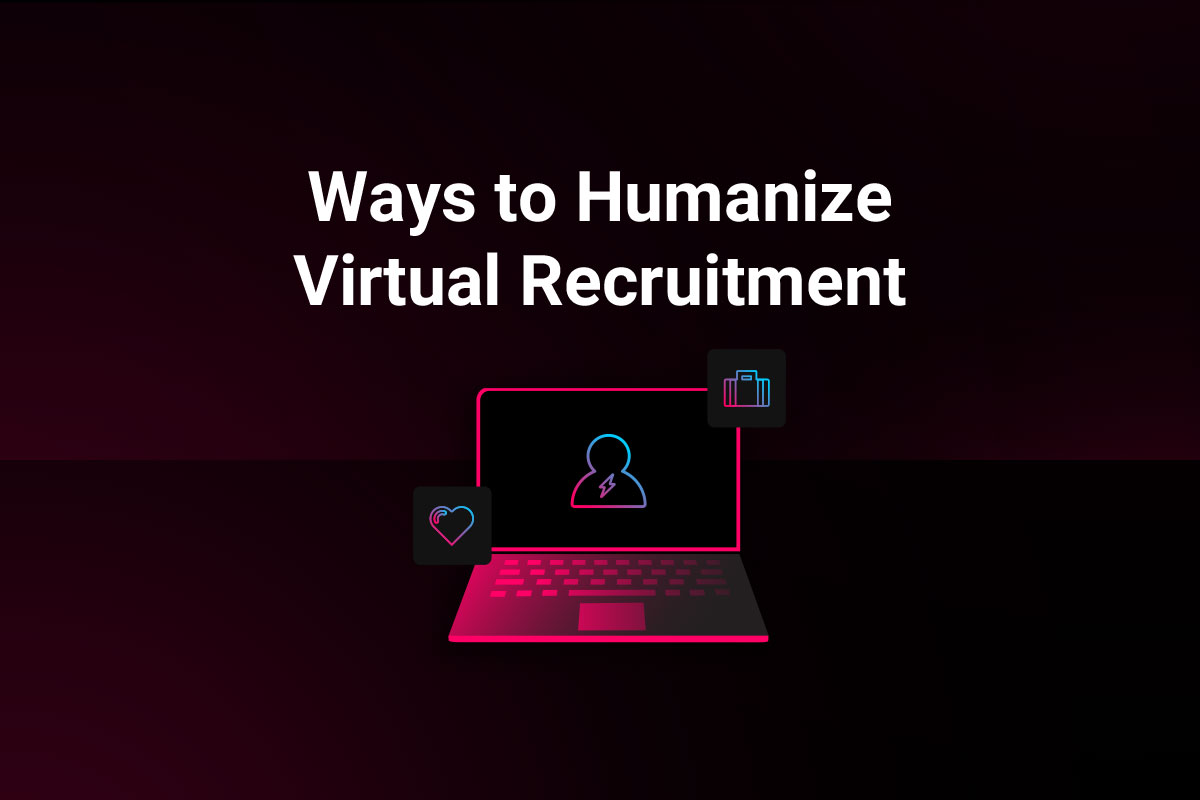
The shift to remote and hybrid work models has opened up a much broader pool of talent for small and medium-sized businesses. As a result, many organizations now rely on virtual recruiting as their default method of sourcing and selecting candidates. While this approach has a number of benefits for both employer and employee, it can result in certain gaps in the recruitment experience. This guide shares tips for how HR and People Teams can humanize the virtual recruitment process to make a positive impression on candidates. and find the best fit for each role.
What is Virtual Recruitment?
Virtual recruitment refers to the practice of remotely sourcing, interviewing, and selecting candidates for employment, instead of the traditional process of meeting candidates face-to-face for several rounds of interviews.
Virtual recruitment allows for more flexible scheduling of video calls to meet and screen potential hires. With the help of technology, virtual recruitment also centralizes and simplifies many of the steps involved in the hiring process, such as reviewing resumes, communicating status updates, and sharing candidate feedback.
5 Benefits of Virtual Recruitment
By leveraging technology and removing the need for in-person meetings, virtual recruitment offers a number of advantages for small businesses and their HR teams.
1. Recruitment Cost Efficiency
Virtual recruitment can significantly reduce the costs associated with hiring. Virtual screening and interviews mean less time is wasted scheduling, conducting and reporting on face-to-face interviews. For fully remote teams, it also eliminates the need to find a physical location in which to meet candidates.
2. Flexibility of Meeting Times
Virtual recruitment makes it easier for candidates to fit interviews into their busy schedules, as travel time to and from office locations is no longer required. Similarly, senior leaders with demanding calendars are more likely to find the time to virtually meet with potential hires..
3. Speed of Recruiting
Virtual recruitment speeds up many aspects of the hiring process. Multiple rounds of interviews can be carried out in quick succession when in-person scheduling is no longer needed. Centralized portals where managers and other interviewers can share feedback on candidates can speed up the decision making process, while online form submissions accelerate the collection of critical documents.
4. Efficiency of Hiring
Software and online tools can address many of the inefficient and time-consuming aspects of the traditional hiring process. Virtual recruitment allows hiring managers to send and receive forms, create and update candidate profiles, perform interviews, and review portfolios without cumbersome paperwork or schedule restrictions.
5. Reach of Candidate Pool
Virtual recruitment opens up your organization to a wider talent pool unrestricted by geographic location. This can introduce new and improved skill sets into your organization, as well as different perspectives that foster innovation. Along with inclusive interview strategies, virtual recruitment can also complement your company’s diversity initiatives.

Leading with Impact: How Diversity, Equity and Inclusion Improves Business
Small businesses may lack the dedicated DEI executives and large committees of the corporate world, but you don’t need vast resources to make real progress.
Watch the Webinar8 Ways to Recruit Virtually while Staying Human
While the automation and efficiency of virtual recruitment are immensely beneficial for HR and People Teams, they can come at the expense of personal experiences for candidates. Follow the best practices below to humanize the virtual recruitment process.
1. Have a Virtual Open Door Policy
Recruiters and hiring managers should make themselves as available to candidates as possible, whether they are selected for the position or not. Keep the lines of communication open and maintain contact with those candidates that have been unsuccessful in their applications – they may be suitable for another role later on.
2. Build Relationships
Hiring managers need to take time to build relationships with their candidates, just as they would in a face-to-face environment. Try to establish a rapport during interviews as this helps the candidate feel more comfortable and relaxed during the process and encourages more open, honest conversations.
3. Use the Available Tools
A number of tools and resources are available to improve the interaction between recruiters and candidates. From virtual interview schedulers to candidate surveys, leverage technology to open more avenues of communication with the talent pool. Just be careful not to rely too heavily on features like AI to screen candidates.
4. Provide Feedback
Feedback is an important step in humanizing virtual recruitment. Unsuccessful candidates appreciate constructive feedback on their interview performance to allow them to make improvements in future applications. And, this leaves a positive impression on those who may reapply successfully in future.
5. Be Consistent
Follow the same processes and procedures for all candidates in your virtual recruitment funnel to ensure a fair and consistent playing field. This also allows for equitable grading and assessment of applicants, and improves the overall experience for all candidates.
6. Conduct Training
If virtual recruitment is new to your organization, hiring managers can benefit from training on the associated systems, tools, and best practices. Instead of simply transitioning previous interview tactics to a virtual environment, HR teams should provide tips on how to effectively adapt to video call scenarios.
7. Invite Feedback
Virtual recruitment is a relatively new concept for all parties involved, and no organization gets it right the first time. Survey both successful and unsuccessful candidates on their experience to find opportunities for improvement, and continuously iterate on your process.
8.Follow Up with Exceptional Onboarding
Your relationship-building efforts shouldn’t end with an offer letter. When a new employee joins your team, continue their journey with an exceptional onboarding experience. This is especially important if the candidate will continue to interact with their new colleagues from a remote location, as you will need to take a more proactive approach to personalizing their early days and weeks as an employee.

Download the Employee Onboarding Checklist
From team introductions and employee swag, to company devices and system access, this employee onboarding checklist covers all of the essentials for welcoming your new hire to the team.
Download the ChecklistDon’t Lose the Personal Touch in Virtual Recruitment
Virtual recruitment is an increasingly popular way to recruit candidates worldwide, giving businesses access to an unlimited pool of potential employees. The use of collaborative technology can also help businesses find efficiencies, reduce costs, and accelerate hiring – all while maintaining positive relationships with candidates. When you find the perfect new hire, make sure to extend this experience with an engaging onboarding process. Get in touch to learn more about Electric’s onboarding solutions.



